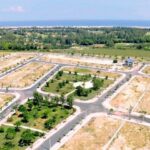Residential Plot Lands: Minimum 50sqm for Subdivision in Many Areas
In alignment with Article 220 of the 2024 Land Law regarding land subdivision and amalgamation, the Hanoi People’s Committee is seeking feedback to finalize the draft regulations on conditions for land subdivision and amalgamation, as well as minimum area and dimensions for subdivision in Hanoi.
This draft aims to concretize the provisions of the 2024 Land Law, establishing a comprehensive and synchronized legal framework for efficient land management and utilization while ensuring security and national defense in the capital.

Hanoi is consulting on draft regulations regarding conditions for land subdivision and amalgamation, and minimum area and dimensions for subdivision.
According to the draft, in cases of subdivision without creating a new access route, the plot in a ward or town must have a length of at least 4m, a width adjacent to the transport route of at least 4m, and an area outside the red line boundary of no less than 50sqm. In communal areas, the minimum area is specified as 80sqm for plains, 100sqm for midland areas, and 150sqm for mountainous regions.
When it comes to subdividing land and creating a new access route, the route must have a minimum width of 3.5m for towns, 4m for plains, and 5m for midland and mountainous areas.
For non-agricultural land, these regulations apply to plots that are not allocated or leased by the State for project implementation. In wards or towns, for commercial and service land, the new plot must have a width adjacent to the transport route of at least 10m and an area of no less than 400sqm.
For other types of non-agricultural land, a width of 20m and an area of no less than 1,000sqm are required. In other communes, commercial and service land must have an area of no less than 800sqm, while other types of non-agricultural land should be no less than 2,000sqm.
Regarding conditions for subdividing agricultural land, these regulations apply to land that is not subject to allocation under the Government’s Decree No. 64-CP (dated September 27, 1993) on the issuance of regulations on the allocation of agricultural land to households and individuals for stable long-term use for agricultural production, and land that is outside the scope of land consolidation and exchange.
Regulations on Land Subdivision and Amalgamation
Article 220 of the Land Law No. 31/2024/QH15 provides specific provisions on land subdivision and amalgamation.
1. Land subdivision and amalgamation must comply with the following principles and conditions:
+ The land plot must be granted one of the following certificates: Land use right certificate, House ownership and land use right certificate, Land use right and asset ownership certificate attached to the land, Land use right and ownership certificate of assets attached to the land;
+ The land plot must be within the land use duration;
+ The land must be free from disputes, not subject to enforcement for execution of judgments, and not subject to temporary emergency measures by competent state agencies.
In cases where there is a dispute, but the disputed area and boundary can be determined, the undisputed area and boundary of the land plot may be permitted for land subdivision and amalgamation;
+ Land subdivision and amalgamation must ensure access, connectivity to existing public transport routes, and reasonable provision for water supply, drainage, and other necessary needs. If the land user dedicates a portion of the residential land plot or a portion of the land plot with residential land and other types of land in the same plot for access, no change of land use purpose is required for that portion when subdividing or amalgamating the land plot.
2- In the case of land subdivision, in addition to the principles and conditions stipulated in Clause 1 of this Article, the following conditions must also be met:
+ The plots resulting from the subdivision must meet the minimum area requirements for the type of land being used, as specified by the Provincial People’s Committee. If the subdivided plot has an area smaller than the minimum allowable subdivision area, it must be amalgamated with an adjacent plot simultaneously;
+ In the case of changing the purpose of a portion of the land plot, the subdivision must be carried out, and the area of the land plot after subdivision must be equal to or greater than the minimum area for the type of land after the change of purpose. For land plots with residential land and other types of land, it is not mandatory to subdivide when changing the purpose of a portion of the land plot, unless the land user requests it;
+ In the case of dividing the right to use land according to a court judgment or decision, if the division does not meet the conditions, area, and dimensions for subdivision as prescribed, the subdivision shall not be carried out.
3- In the case of land amalgamation, in addition to the principles and conditions stipulated in Clause 1 of this Article, the following conditions must also be satisfied:
+ The amalgamation of land plots must ensure the same land use purpose, land use duration, and land rent payment method, except for the amalgamation of land plots with residential land and other types of land in the same plot, and the amalgamation of land plots with residential land and other types of land in different plots;
+ In cases where the amalgamated land plots differ in terms of land use purpose, land use duration, or land rent payment method, the procedures for changing the land use purpose, adjusting the land use duration, or changing the land rent payment method must be carried out simultaneously to unify them according to the provisions of the law.
4- The Provincial People’s Committee shall, based on the provisions of Clauses 1, 2, and 3 of this Article, other relevant legal provisions, and local customs and practices, specify the conditions and minimum area for land subdivision and amalgamation for each type of land.
Is Investing in Subdivided Land a Smart Move Now that the Real Estate Business Law is in Effect?
According to experts, when the amended Real Estate Business Law comes into force, land subdivision will be the most affected due to the prohibition on lot splitting. This new regulation is expected to have a significant impact on the real estate market, particularly on developers and investors who have relied on this practice. The law aims to address issues related to speculative investments and ensure more sustainable development practices in the industry.
The Crowd Mentality at Land Auctions: Defying Market Trends
A record-breaking land auction in terms of participation, with winning bids soaring 5-6 times higher than the reserve price and surpassing the average for Hanoi’s outlying districts. This phenomenon has sparked discussions among experts, with some attributing it to “herd mentality” and others suspecting potential real estate price manipulation.

















